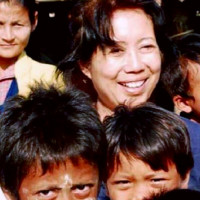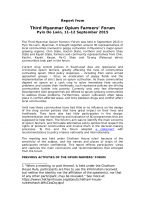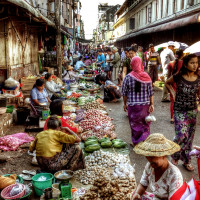People’s War on Drugs in Kachin State: Indication of Failed Policies
The creation of Pat Jasan and its ‘people’s war on drugs' have brought to light drug-related problems facing not only the Kachin State but also the rest of the country. Praised by some Kachin activists for finally addressing drug problems, they are also criticised by others for violating human rights and not providing any services to marginalised communities, including drug users and poppy farmers.

Pailin Wedel
Communities in the Kachin State have launched a ‘people’s war on drugs’. Known as Pat Jasan (‘Prohibit Clear’), a new organisation was formed two years ago to combat the worsening drug problem among the local population. The self-appointed committee decided to take law enforcement into their own hands as they feel the government is not doing enough to stop the flow of harmful drugs into their communities.
The Pat Jasan vigilantes, often dressed in military-style uniforms and armed with stick and batons, have arrested and beaten drug users and put them into forced treatment camps, and they have sent teams into opium-growing areas to eradicate poppy fields. The Pat Jasan has been praised by some Kachin activists for finally addressing drug problems, but criticized by others for violating human rights and not providing any services to marginalized communities, including drug users and poppy farmers. Most recently, their poppy eradication efforts led to open conflict with opium farmers and local militia groups.
The creation of Pat Jasan and its war on drugs have brought to light a number of key drug-related problems facing not only the Kachin State but also the rest of the country.
First, there are widespread and serious drug-related problems in Myanmar. Problematic drug use has been reportedly rampant for at least two decades, and there is little evidence to suggest that the situation is improving. Some areas in the country, especially Kachin and northern Shan States, are facing a heroin epidemic, with devastating consequences for local communities. Injecting heroin use is one of the main drivers of the spread of HIV/AIDS in the country, and HIV prevalence among injecting drug users in the Kachin State is, according to statistics released yearly by the Myanmar Ministry of Health, among the highest in the country and in South-East Asia. Scores of young people die prematurely every year of drug use problems, including overdoses, although reliable data does not exist. Problems caused by drug addiction within families and communities have never been more acutely felt. According to a representative of a Kachin civil society organisation: “More Kachin people have died of drug-related problems than because of armed conflict."
Second, current policies to address these problems are clearly failing. The response by the central government and local authorities to this tragedy is very inadequate. The current legal framework focuses on arresting and criminalizing drug users. Arrests conducted by law enforcement agencies mostly target drug users or small-scale dealers. In contrast, very few major traffickers, corrupt officials or militia leaders involved in the drug trade are ever prosecuted. As a result, a very large part of the prison population in Myanmar, especially in northern regions, consists of drug users.
Drug treatment facilities, too, are largely insufficient. There are only two public hospitals offering drug detoxification services for the entire Kachin State – in Myitkyina and Bamaw, and not a single government-run rehabilitation centre is operational at present. Overall, the weakness of the national response starkly contrasts with the enormous show of opportunism and business priority that are deployed to exploit the rich natural resources of the Kachin state, including jade, timber and gold.
Third, there are many links between drugs and the continuing conflict in the country. After decades of civil war, many conflict actors rely on the drug trade to finance their armies and operations. Corruption is a big problem in Myanmar, and many representatives of government agencies and the Tatmadaw also profit from the drug trade. In consequence, drug producers and traffickers appear to have been given a free hand by the authorities.
Myanmar government officials privately admit that several Tatmadaw-supported militias are heavily involved in amphetamine and heroin production and trade. However, their relationship with the Tatmadaw, whose priority is security and not drugs, makes these militia groups untouchable. Many of these militias have no other political objectives than to maintain the status quo and continue with their businesses. Some of their leaders have even been elected into parliament in the 2010 and 2015 general elections.
At the same time, there has been a tendency to blame ethnic armed opposition groups for the drugs trade, some of which have strong anti-narcotics policies and who are calling for federal reform, based on democratic principles, to resolve the country’s social and political problems. This marginalization of those calling for reform has greatly frustrated local communities and raised serious questions about the sincerity of central governments to address the country’s drug problems, listen to ethnic nationality grievances and aspirations, and achieve a sustainable peace.
Against this backdrop of failure, communities in the Kachin State have decided to take things into their own hands. Initiated by members of the Kachin Baptist Convention, the Pat Jasan was set up. But the movement has rapidly gained momentum and is now gathering support way beyond its KBC start. Its popularity is the result of long-time accumulated frustration and anger endured by communities living in the Kachin State over neglect and ineffective drug policies.
Supporters of the Pat Jasan movement are happy that finally someone is taking action against the drug problem in the Kachin State. However, without addressing the root causes of problematic drug use, production and trafficking in the Kachin State and country as a whole, the problem is unlikely to go away. Blaming and targeting the weakest links in the drug trade – marginalised drug users and opium farmers – is also problematic as these people need social support rather than punishment. It will not solve the underlying crisis. Punishing them will only push them into further misery and poverty. Instead, it is time that the government and other concerned actors start targeting those really controlling and profiting from the trade: i.e., the larger traffickers and those who support them.
In the field, the problems do not end here. In recent months, the militant activities of Pat Jasan have risked creating new conflicts among the local population. In particular, Shan communities in the Kachin State have complained that the arrest of members of their community by ethnic Kachin Pat Jasan members, and sometimes handing them over to the armed opposition Kachin Independence Organisation, is feeding into existing tensions between Shan and Kachin communities. At this critical period in the country’s history, this is a very sensitive issue that needs to be handled carefully. As Myanmar’s political transition continues, it is important to promote peace and inclusion rather than aggravating community grievances and conflicts.
In summary, among the many challenges facing the country today, it is now vital to acknowledge the magnitude of the drug use epidemic in the Kachin State and other northern regions, and to develop a set of policies that will match the severity of problems caused by drug use and production. To be successful, such policies should be made in consultation with affected communities, who include drug users themselves and impoverished poppy-farmers growing opium as a means to survive.
A real debate also needs to be held around the different strategies that can be adopted to tackle the detrimental problems caused by drug use and production. After decades of the international ‘war on drugs’, a growing number of countries are moving away from this one-dimensional approach and are recognizing that strategies merely based on repression have actually failed to produce results and only made matters worse. Most recently, the United States of America, which has long led this international endeavour, has begun considering different approaches to drug control because of this history of failure. Therefore, as international strategies change, the question is whether another ‘war on drugs’ in the Kachin State, launched out of frustration, is really the best option.
The encouraging news is that there are alternative methods that have proved effective in addressing the most serious problems caused by drug use and production. Many countries have already introduced them with success, and there are many experiences and materials available that can be learned from. In general, such policies consist of placing the focus of interventions on supporting the most vulnerable – the drug users and small-scale impoverished farmers – rather than punishing them, while police and judicial efforts are re-directed on dealing with major drug-related offences.
Based upon these experiences, what will be needed at the community level in Myanmar in the coming years is the provision of effective treatment and services for drugs users in different parts of the country, which are voluntary, based on needs and respect human rights. Similarly, as most opium-cultivating communities grow poppy as a livelihood strategy, the development of their communities should be prioritized rather than arresting individuals and destroying their livelihoods.
In short, the drug crisis in the Kachin State is an urgent warning of the failures of anti-narcotic policies in the past and a wake-up call for inclusive, informed and reflective actions that are in partnership with the local peoples in the future.
This commentary is part of a TNI project funded by Sweden.



